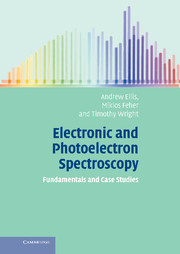Book contents
- Frontmatter
- Contents
- Preface
- List of journal abbreviations
- Part I Foundations of electronic and photoelectron spectroscopy
- 1 Introduction
- 2 Electronic structure
- 3 Angular momentum in spectroscopy
- 4 Classification of electronic states
- 5 Molecular vibrations
- 6 Molecular rotations
- 7 Transition probabilities
- Part II Experimental techniques
- Part III Case Studies
- Appendix A Units in spectroscopy
- Appendix B Electronic structure calculations
- Appendix C Coupling of angular momenta: electronic states
- Appendix D The principles of point group symmetry and group theory
- Appendix E More on electronic configurations and electronic states: degenerate orbitals and the Pauli principle
- Appendix F Nuclear spin statistics
- Appendix G Coupling of angular momenta: Hund's coupling cases
- Appendix H Computational simulation and analysis of rotational structure
- Index
- References
7 - Transition probabilities
Published online by Cambridge University Press: 05 June 2012
- Frontmatter
- Contents
- Preface
- List of journal abbreviations
- Part I Foundations of electronic and photoelectron spectroscopy
- 1 Introduction
- 2 Electronic structure
- 3 Angular momentum in spectroscopy
- 4 Classification of electronic states
- 5 Molecular vibrations
- 6 Molecular rotations
- 7 Transition probabilities
- Part II Experimental techniques
- Part III Case Studies
- Appendix A Units in spectroscopy
- Appendix B Electronic structure calculations
- Appendix C Coupling of angular momenta: electronic states
- Appendix D The principles of point group symmetry and group theory
- Appendix E More on electronic configurations and electronic states: degenerate orbitals and the Pauli principle
- Appendix F Nuclear spin statistics
- Appendix G Coupling of angular momenta: Hund's coupling cases
- Appendix H Computational simulation and analysis of rotational structure
- Index
- References
Summary
Depending on the resolution, a spectrum may consist of well-resolved discrete peaks, each of which is attributable to a single specific transition, or it may consist of broader bands that are actually composed of several unresolved transitions. In either case, the intensities will depend on a number of factors. The sensitivity of the spectrometer is crucial. So too is the concentration of the absorbing or emitting species. However, our interest in the remainder of this chapter is with the intrinsic transition probability, i.e. the part that is determined solely by the specific properties of the molecule. The key to understanding this is the concept of the transition moment.
Transition moments
Consider two pairs of energy levels, one pair in molecule A and one pair in a completely different molecule B. Assume for the sake of simplicity that the energy separation between the pair of levels is exactly (and fortuitously) the same for both molecules. Suppose that a sample of A is illuminated by a stream of monochromatic photons with the correct energy to excite A from its lower to its upper energy level. There will be a certain probability that a molecule is excited per unit time. Now suppose sample A is replaced with B, keeping the concentration and all other experimental conditions unchanged. In general the probability of photon absorption per unit time for B would be different from A, perhaps by a very large amount.
- Type
- Chapter
- Information
- Electronic and Photoelectron SpectroscopyFundamentals and Case Studies, pp. 51 - 64Publisher: Cambridge University PressPrint publication year: 2005



